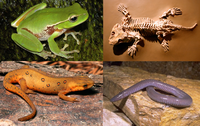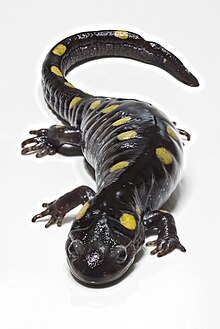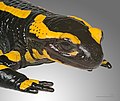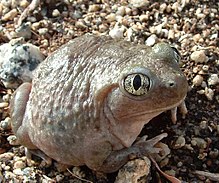Introduction
Selected amphibian type
Salamanders are a group of amphibians typically characterized by their lizard-like appearance, with slender bodies, blunt snouts, short limbs projecting at right angles to the body, and the presence of a tail in both larvae and adults. All ten extant salamander families are grouped together under the order Urodela from the group Caudata. Urodela is a scientific Latin term based on the Ancient Greek οὐρά δήλη: ourà dēlē "conspicuous tail". Caudata is the Latin for "tailed ones", from cauda : "tail".
Salamander diversity is highest in eastern North America, especially in the Appalachian Mountains; most species are found in the Holarctic realm, with some species present in the Neotropical realm. Salamanders never have more than four toes on their front legs and five on their rear legs, but some species have fewer digits and others lack hind limbs. Their permeable skin usually makes them reliant on habitats in or near water or other cool, damp places. Some salamander species are fully aquatic throughout their lives, some take to the water intermittently, and others are entirely terrestrial as adults.
This group of amphibians is capable of regenerating lost limbs as well as other damaged parts of their bodies. Researchers hope to reverse engineer the regenerative processes for potential human medical applications, such as brain and spinal cord injury treatment or preventing harmful scarring during heart surgery recovery. The remarkable ability of salamanders to regenerate is not just limited to limbs but extends to vital organs such as the heart, jaw, and parts of the spinal cord, showing their uniqueness compared to different types of vertebrates. This ability is most remarkable for occurring without any type of scarring. This has made salamanders an invaluable model organism in scientific research aimed at understanding and achieving regenerative processes for medical advancements in human and animal biology. (Full article...)
Selected frog article
The Pipidae are a family of primitive, tongueless frogs. There are 41 species in the family, found in tropical South America (genus Pipa) and sub-Saharan Africa (the three other genera). (Full article...)
Selected salamander article

Sexual selection in amphibians involves sexual selection processes in amphibians, including frogs, salamanders and newts. Prolonged breeders, the majority of frog species, have breeding seasons at regular intervals where male-male competition occurs with males arriving at the waters edge first in large number and producing a wide range of vocalizations, with variations in depth of calls the speed of calls and other complex behaviours to attract mates. The fittest males will have the deepest croaks and the best territories, with females making their mate choices at least partly based on the males depth of croaking. This has led to sexual dimorphism, with females being larger than males in 90% of species, males in 10% and males fighting for groups of females.
There is a direct competition between males to win the attention of the females in salamanders and newts, with elaborate courtship displays to keep the females attention long enough to get her interested in choosing him to mate with. Some species store sperm through long breeding seasons, as the extra time may allow for interactions with rival sperm. (Full article...)
The page "User:The Transhumanist/Sandbox144/box-header" does not exist.The page "User:The Transhumanist/Sandbox144/DYK/4" does not exist.
Picture slideshow
Selected toad article
Spea is a genus of North American amphibian commonly referred to as the western spadefoot toads. They differ greatly from true toads (those of the family Bufonidae) by having eyes with vertical pupils, no parotoid glands, and relatively smooth skin. Their most distinctive feature is a spade-like projection on their hind feet, from which their common name is derived. This projection enables spadefoot toads to dig in loose soils with ease.Its name is from the Ancient Greek speos (σπέος, ‘cave, cavern’) (Full article...)
Selected caecilian article
The Siphonopidae are the family of common caecilians. They are found in Central and South America. Like other caecilians, they superficially resemble worms or snakes.
They are the sister group to Dermophiidae, also of South America. Siphonopids are oviparous caecilians, meaning they lay eggs. They have imperforated stapes and no inner mandibular teeth. Like species of some other caecilian families, their skulls have relatively few bones, with those present being fused to form a solid ram to aid in burrowing through the soil. The mouth is recessed beneath the snout, and there is no tail. (Full article...)
Categories
Topics
Related portals

Salamanders
Frogs and toads
Paleontology
Extinct and Endangered Species
Paleozoic
Mesozoic
Cenozoic
Reptiles
Birds
Associated Wikimedia
The following Wikimedia Foundation sister projects provide more on this subject:
- Commons
Free media repository - Wikibooks
Free textbooks and manuals - Wikidata
Free knowledge base - Wikinews
Free-content news - Wikiquote
Collection of quotations - Wikisource
Free-content library - Wikiversity
Free learning tools - Wiktionary
Dictionary and thesaurus

























































